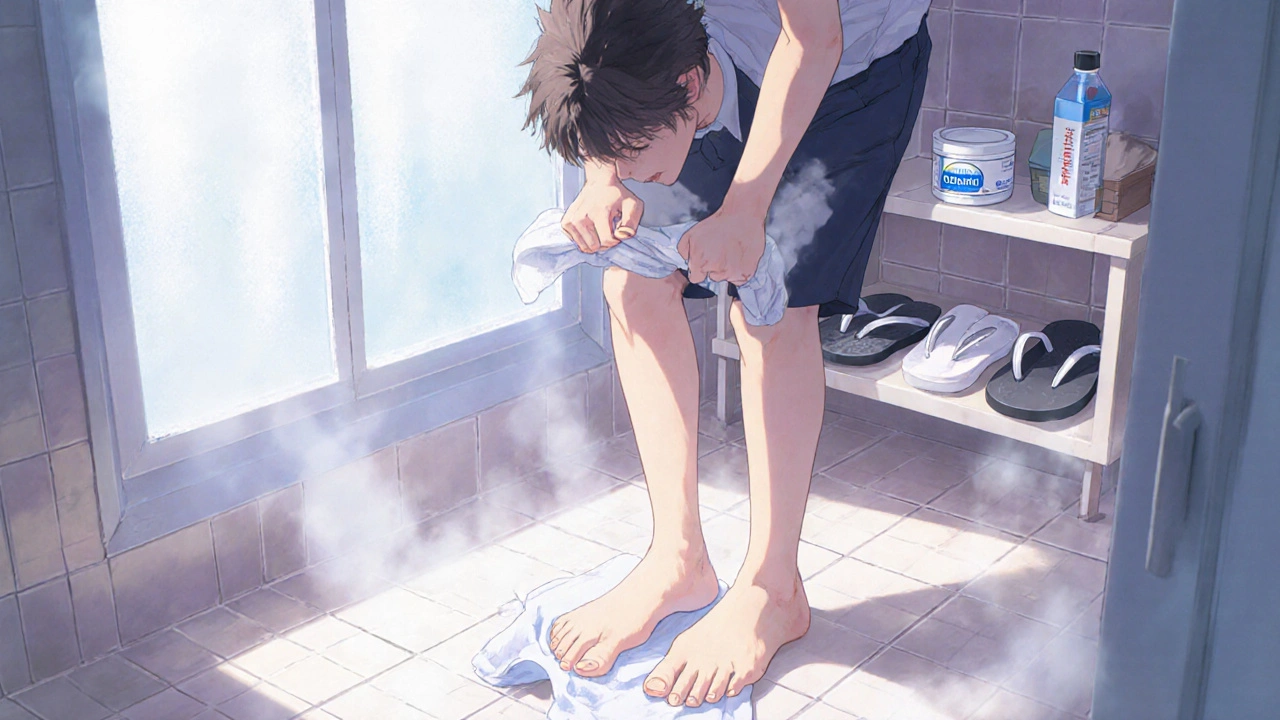
Most people think fungal infections are just annoying rashes or itchy feet. But left unchecked, they can spread, get worse, and even lead to serious problems-especially if you have a weak immune system, diabetes, or wear damp clothes all day. The good news? You don’t always need medication. In fact, most fungal infections can be stopped before they start. And when you do need treatment, ketoconazole isn’t always the first or best choice.
What causes fungal infections in the first place?
Fungi live everywhere-on your skin, in the soil, in your shower. They only become a problem when they grow out of control. That usually happens when conditions are warm, moist, and dark. Think sweaty socks, tight underwear, or not drying your skin properly after swimming. People who take antibiotics often get yeast infections because the good bacteria that keep fungi in check get wiped out. Diabetics are more prone too-high sugar levels feed the fungus.
Common types include:
- Tinea pedis (athlete’s foot): flaky, cracked skin between the toes
- Tinea cruris (jock itch): red, ring-shaped rash in the groin
- Candidiasis: oral thrush or vaginal yeast infection
- Tinea corporis: ringworm on the body
- Pityriasis versicolor: light or dark patches on the chest or back
These aren’t contagious in the way a cold is, but they can spread through shared towels, gym equipment, or even walking barefoot in public showers.
Prevention: Simple habits that work
You don’t need fancy products or expensive creams to stop fungal infections. Just change a few daily habits.
- Dry thoroughly after bathing. Pay attention to between your toes, under your breasts, and your groin. Use a separate towel for your feet if you have athlete’s foot.
- Wear breathable fabrics. Cotton underwear and loose-fitting clothes let skin breathe. Avoid synthetic materials like polyester that trap sweat.
- Change socks and underwear daily. If you sweat a lot-like after a workout-change midday. Moisture is fungus’s favorite snack.
- Don’t walk barefoot in public showers. Flip-flops aren’t just for fashion-they’re your first line of defense.
- Keep your shoes dry. Rotate your shoes so they have 24 hours to air out. Spraying the inside with antifungal powder once a week helps too.
- Avoid sharing personal items. Towels, combs, and nail clippers can carry fungal spores.
- Control blood sugar if you’re diabetic. High glucose = more fuel for yeast. Regular monitoring cuts infection risk by half.
These steps aren’t optional if you’ve had a fungal infection before. They’re your daily routine-like brushing your teeth.
When does ketoconazole actually help?
Ketoconazole is an antifungal medication. It’s been around since the 1980s and comes in creams, shampoos, and pills. But here’s the thing: most people don’t need the pill form. And even the topical versions aren’t always the first recommendation anymore.
Topical ketoconazole (like Nizoral shampoo or cream) works well for:
- Pityriasis versicolor (skin discoloration)
- Seborrheic dermatitis (dandruff, flaky scalp)
- Mild to moderate tinea infections when other treatments fail
But for athlete’s foot or jock itch? Over-the-counter clotrimazole or terbinafine work just as well-and cost less. For vaginal yeast infections? Fluconazole (a single pill) is faster and more effective than creams.
Oral ketoconazole? It’s rarely used now. Why? Because it can damage your liver. The FDA restricted its use in 2013 for systemic fungal infections because safer alternatives exist. Doctors only consider it if:
- Other antifungals have failed
- The infection is deep or widespread (like in immunocompromised patients)
- There’s no other option
And even then, liver function tests are required before and during treatment. It’s not something you pick up at the pharmacy without a prescription-and it shouldn’t be your go-to.

What to use instead of ketoconazole
There are better, safer, and cheaper options for most cases:
| Infection Type | Best First Treatment | Why It’s Better |
|---|---|---|
| Athlete’s foot | Terbinafine cream (Lamisil) | Works faster, fewer applications, lower relapse rate |
| Jock itch | Clotrimazole cream | Available OTC, safe for daily use, minimal side effects |
| Vaginal yeast infection | Fluconazole 150mg pill | One dose, cures 90% of cases in 3 days |
| Dandruff / scalp fungus | Ketoconazole shampoo (2%) | Still the gold standard for seborrheic dermatitis |
| Pityriasis versicolor | Ketoconazole shampoo or cream | Highly effective for this specific fungus |
Clotrimazole and terbinafine have been studied in over 100 clinical trials. They’re more targeted, less toxic, and just as effective. Ketoconazole cream is fine for scalp or skin discoloration-but don’t reach for it for a simple rash unless your doctor says so.
Red flags: When to see a doctor
Fungal infections often clear up in 1-2 weeks with OTC treatment. But if you see any of these, stop self-treating and get help:
- The rash spreads beyond the initial area
- It doesn’t improve after 2 weeks of treatment
- You have pain, swelling, or pus
- You have diabetes, HIV, or are on chemotherapy
- You keep getting the same infection back
Recurrent infections could mean an underlying issue-like undiagnosed diabetes, a weakened immune system, or even a misdiagnosis. What looks like ringworm could be psoriasis or eczema. A doctor can do a simple skin scraping test to confirm it’s fungal.

Myths about fungal infections and ketoconazole
There’s a lot of misinformation out there.
- Myth: “Ketoconazole is the strongest antifungal.”
Truth: It’s not. Terbinafine kills fungi faster. Ketoconazole just stops them from growing. - Myth: “I used ketoconazole shampoo and it cleared my acne.”
Truth: It might help seborrheic dermatitis mistaken for acne-but it doesn’t treat bacterial acne. Don’t use it for that. - Myth: “Taking ketoconazole pills prevents future infections.”
Truth: Oral ketoconazole doesn’t prevent anything. It treats active infections. Long-term use is dangerous. - Myth: “If I use it once, I won’t get it again.”
Truth: Fungi live on your skin. Without changing habits, it will come back.
Antifungals aren’t magic bullets. They’re tools. Prevention is the real cure.
Final advice: Keep it simple
Most fungal infections are preventable. You don’t need to stockpile antifungal creams. You don’t need to chase the “strongest” drug. Just:
- Stay dry
- Wear clean, breathable clothes
- Use OTC creams like clotrimazole or terbinafine for minor cases
- Reserve ketoconazole for scalp issues or stubborn skin discoloration
- See a doctor if it doesn’t improve or keeps coming back
It’s not about fighting fungi with chemicals. It’s about making your skin an unwelcome place for them to live.
Can I use ketoconazole shampoo every day?
No. Ketoconazole shampoo is meant for use 2-3 times a week for treatment, then once a week for maintenance. Daily use can dry out your scalp and cause irritation. It’s not a regular shampoo substitute.
Is ketoconazole safe during pregnancy?
Topical ketoconazole (cream or shampoo) is generally considered low risk during pregnancy because very little is absorbed into the bloodstream. But oral ketoconazole is not safe and should be avoided. Always check with your doctor before using any medication while pregnant.
Can fungal infections spread to internal organs?
In healthy people, no. Fungal infections like athlete’s foot or yeast infections stay on the skin or mucous membranes. But in people with weakened immune systems-like those on chemotherapy or with advanced HIV-fungi can enter the bloodstream and cause life-threatening systemic infections. That’s why early treatment matters.
How long does it take for ketoconazole cream to work?
For skin conditions like pityriasis versicolor or seborrheic dermatitis, you may see improvement in 1-2 weeks. But full clearance can take 4-6 weeks. Don’t stop using it just because the itching stops. Finish the full course to prevent recurrence.
Are natural remedies like tea tree oil effective?
Some studies show tea tree oil has antifungal properties, but it’s not as reliable as FDA-approved treatments. It can also irritate sensitive skin. If you want to try it, dilute it with a carrier oil and patch test first. But don’t rely on it alone for persistent or severe infections.
Comments (9)
-
phenter mine October 30, 2025
i just realized i’ve been using the same towel for my feet and body for months 😅 guess thats why my athlete’s foot keeps coming back. time to buy new ones and actually dry between my toes. thanks for the wake-up call!
-
Aditya Singh October 30, 2025
Let me preface this by saying that your entire premise is fundamentally flawed due to a misinterpretation of mycological pathogenesis. Fungi aren't merely 'warm and moist' opportunists-they're dimorphic saprophytes exploiting keratinized epithelial substrates under immunomodulatory dysregulation. Ketoconazole, despite its hepatotoxicity, remains a broad-spectrum azole with potent CYP3A4 inhibition, making it pharmacokinetically superior to terbinafine in biofilm-penetrating scenarios, especially in chronic tinea corporis with subclinical immunosuppression. You're promoting OTC agents as panaceas, which is dangerously reductive. The real issue? Lack of mycological diagnostics in primary care.
-
Katherine Reinarz October 30, 2025
OMG I JUST HAD A YEAST INFECTION LAST WEEK AND I THOUGHT IT WAS JUST ‘NORMAL’ 😭 I’VE BEEN WEARING NYLON PANTS FOR A YEAR AND NOW I FEEL SO GUILTY. I’M GOING TO BUY COTTON UNDIES TODAY AND I’M TELLING MY BOYFRIEND TO STOP SHARING MY TOWELS. I’M SO EMBARRASSED 😭😭😭
-
John Kane October 31, 2025
Hey everyone, I just want to say how much I appreciate this post-it’s the kind of practical, no-nonsense health advice we need more of. I’m from India originally, and I remember my grandma always saying, ‘Dry your feet like you’re drying a baby’s face.’ Turns out, she was basically a fungal prevention ninja. I’ve been using terbinafine cream for my athlete’s foot for years now, and it’s been a game-changer. Also, rotating shoes? Life-changing. I used to wear the same pair for weeks until my feet smelled like a gym sock left in a locker. Now I rotate them like I rotate my Netflix shows. And yes, flip-flops in showers? Non-negotiable. Seriously, if you’ve ever had a fungal issue, just do the basics. It’s not glamorous, but it works. And if you’re diabetic? Please, please, please check your feet daily. I’ve seen too many people ignore it until it’s too late. You’re not being dramatic-you’re being smart. Keep it simple, stay dry, and don’t let fear of meds stop you from doing what’s right. You’ve got this.
-
Callum Breden November 1, 2025
This article is a textbook example of amateur medical misinformation. You trivialize a complex dermatological domain by reducing it to 'dry your feet' and 'wear cotton.' Ketoconazole's restriction by the FDA was not due to 'safer alternatives'-it was due to irreversible hepatic toxicity and unpredictable pharmacokinetics. Your comparison of clotrimazole and terbinafine ignores pharmacodynamic half-lives and resistance profiles. Furthermore, your dismissal of oral ketoconazole as 'rarely used' is misleading; in immunocompromised patients with disseminated candidiasis or chromoblastomycosis, it remains a critical salvage therapy when echinocandins are unavailable. You are not a clinician. Do not give medical advice.
-
Mansi Gupta November 2, 2025
Thank you for this thoughtful breakdown. I’ve had recurrent jock itch for years, and I never realized how much my synthetic workout gear was contributing. I switched to cotton blends last month and haven’t had a flare-up since. I also started using clotrimazole cream instead of grabbing the ketoconazole shampoo I had lying around-turns out, it was overkill. The point about not sharing towels hit home too. My sister and I used to share one after yoga, and now I feel bad. Simple changes, big difference. I appreciate the clarity.
-
Erin Corcoran November 3, 2025
YESSSS this is sooo helpful!! 😊 I used to use ketoconazole shampoo for my scalp flakes and thought it was magic… until my scalp got so dry I looked like a cactus 🤪 Now I use it once a week max and my hair’s actually healthy again. Also, I started putting antifungal powder in my shoes like you said-no more stinky gym shoes! 💪✨ P.S. If you’re diabetic, please just check your feet. I’ve seen my uncle’s toes turn weird colors and he didn’t go to the doctor for months… don’t be him 😅
-
shivam mishra November 5, 2025
As a pharmacist in Mumbai, I see this all the time. People walk in asking for ketoconazole pills because ‘it’s the strongest’-and then they’re shocked when their liver enzymes spike. The truth? 90% of fungal cases here are treated perfectly fine with terbinafine cream or fluconazole. We even have OTC kits now with a test strip and cream combo. Prevention is 10x easier than treatment. I tell my patients: if your skin feels damp for more than 2 hours, it’s already a party for fungi. Change clothes. Dry well. Wear flip-flops. No magic. Just consistency. And if it doesn’t improve in 10 days? See a doctor. No shame in that.
-
Scott Dill November 5, 2025
Wait-so I’ve been using ketoconazole shampoo as my daily shampoo for 3 years?? 😳 I thought it was just ‘anti-dandruff’ and didn’t realize it was meant for 2-3x a week. No wonder my scalp feels like sandpaper. I’m switching to a regular sulfate-free shampoo now and only using Nizoral once a week. Also, I just bought my first pair of flip-flops for the shower. I feel like a new person. Thanks for the reality check!
